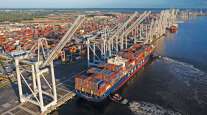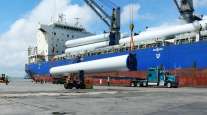Senior Reporter
Most Ports Post Strong 2019 Despite Trump Tariffs

[Stay on top of transportation news: Get TTNews in your inbox.]
As the nation’s major ports add up the number of 20-foot-containers (TEUs) processed at their facilities in 2019, the numbers either slightly exceeded or came close to breaking 2018’s record-level figures, despite a year of diminished trade with China because of the Trump administration’s tariffs.
The nation’s busiest port, the Port of Los Angeles, finished the year with near-record cargo despite the tariffs, which port officials say hurt business, especially in the second half.
The port closed 2019 with 9,337,632 TEUs processed, down 1.28% from 2018’s record of 9,458,748. However, TEU volume in December showed a 17.3% year-over-year drop as the port processed 746,749 TEUs in 2019 compared with 903,258 last December.
“In the face of lagging exports due to international trade tensions and tariff uncertainties, the Port of Los Angeles has maintained strong momentum and kept cargo flowing,” Executive Director Gene Seroka said. “This feat was only possible because of the extensive cooperation and continued efficiency improvements by our terminal operators, supply chain partners and longshore workforce.”

Seroka
Seroka has been an outspoken critic of tariffs, saying they put hundreds of thousands of jobs and billions of dollars in economic activity at risk.
Nearby Port of Long Beach had a 10.3% year-over-year drop in December. The port processed 665,261 TEUs compared with 741,647 in 2018.
For the year, the port still finished with its second-strongest year in its 109-year history as workers loaded and unloaded 7,632,032 TEUs, compared with 8,091,023 in 2018. While the numbers are down for both facilities, officials see a silver lining in the new U.S.-Mexico-Canada Trade Agreement. Officials say they expected to see more imported component parts shipped from Asia through Los Angeles and Long Beach and then shipped by rail or truck to assembly facilities in North America.
“At the end of the day, we need to be ready for whatever may come,” Long Beach Executive Director Mario Cordero said in his annual State of the Port address Jan. 22. “We need to compete, we need to innovate, we need to lead. And most of all, we need to collaborate.”
The Northwest Seaport Alliance, which operates facilities in Seattle and Tacoma, Wash., reported 2019 TEU volume is down 0.6% as those facilities processed 3,775,303 TEUs compared with 3,797,635 in 2018. December also saw an 18.5% year-over-year decrease as the ports processed 284,452 TEUs compared with 349,055 in 2018.

Trucks at the Port of Seattle gate. (Port of Seattle)
At the Port of Oakland, TEU volume in December dropped 12.2%, to 193,963 containers in 2019 from 220,926 in the same period a year ago. For the year, volume dipped 1.9%, to 2,497,355 TEUs from 2,546,351 in 2018.
“We are looking to improve on this cargo performance in the coming year, especially if the U.S. and China can continue to break down trade barriers,” Port of Oakland Maritime Director John Driscoll said.
Port Houston reported it processed 250,946 TEUs in December, a 13.3% increase over the same period in 2018 when 221,358 TEUs were moved.
For the year, the Gulf Coast port increased by 10.6% the number of TEUs it processed, to 2,987,291 in 2019 from 2,699,850 in 2018.
Officials say with the increase the facility is the fastest growing container port in North America.
In part one of a two-part exploration of autonomous technology today, our latest RoadSigns podcast revisits conversations with CEOs Alex Rodrigues of Embark and Cetin Mericli of Locomation. Hear them explain what testing automated trucks and developing platooning technology has taught them about the road ahead — and get new perspective with host commentary. Listen to a snippet from Rodrigues above, and to hear the full episode, go to RoadSigns.TTNews.com.
On the East Coast, the nation’s third-busiest port, the Port of New York and Jersey, finished the year 4.1% ahead of 2018’s record pace, but the facility saw a 4% decline in volume in December, processing 584,743 TEUs compared with 609,390 in 2018.
On an annual basis, the port processed 7,471,131 TEUs in 2019 compared with 7,179,788 a year earlier.
The Port of Virginia also saw a decline in December, but like the Port of New York and New Jersey, it finished the year with a record. For the month, TEU volume was down 4.6% year over-year as the facility processed 224,902 TEUs compared with 241,121 in 2018. However, on an annual basis, volume was up 2.9%, to 2,937,962 from 2,855,904 a year earlier.
“2019 was a landmark year for the Port of Virginia,” Port Authority CEO John Reinhart said. “We had a very successful year, having set a new record for volume, though our growth was not as much as we had planned. Trade thrives in a predictable environment, and the tariffs created some uncertainty across the industry.”
The South Carolina Ports Authority reported December 2019 TEU numbers declined 5.9%, to 187,882 compared with 199,701 in 2018. However, the port set a volume record for the second year in a row, processing 2,436,185 TEUs in 2019 compared with 2,316,255 in 2018. The Port of Savannah in Georgia did not release its December 2019 or end-of-year figures, citing a policy to make the numbers public at its bi-monthly board meeting, which is scheduled for Jan. 28.
Want more news? Listen to today's daily briefing:





